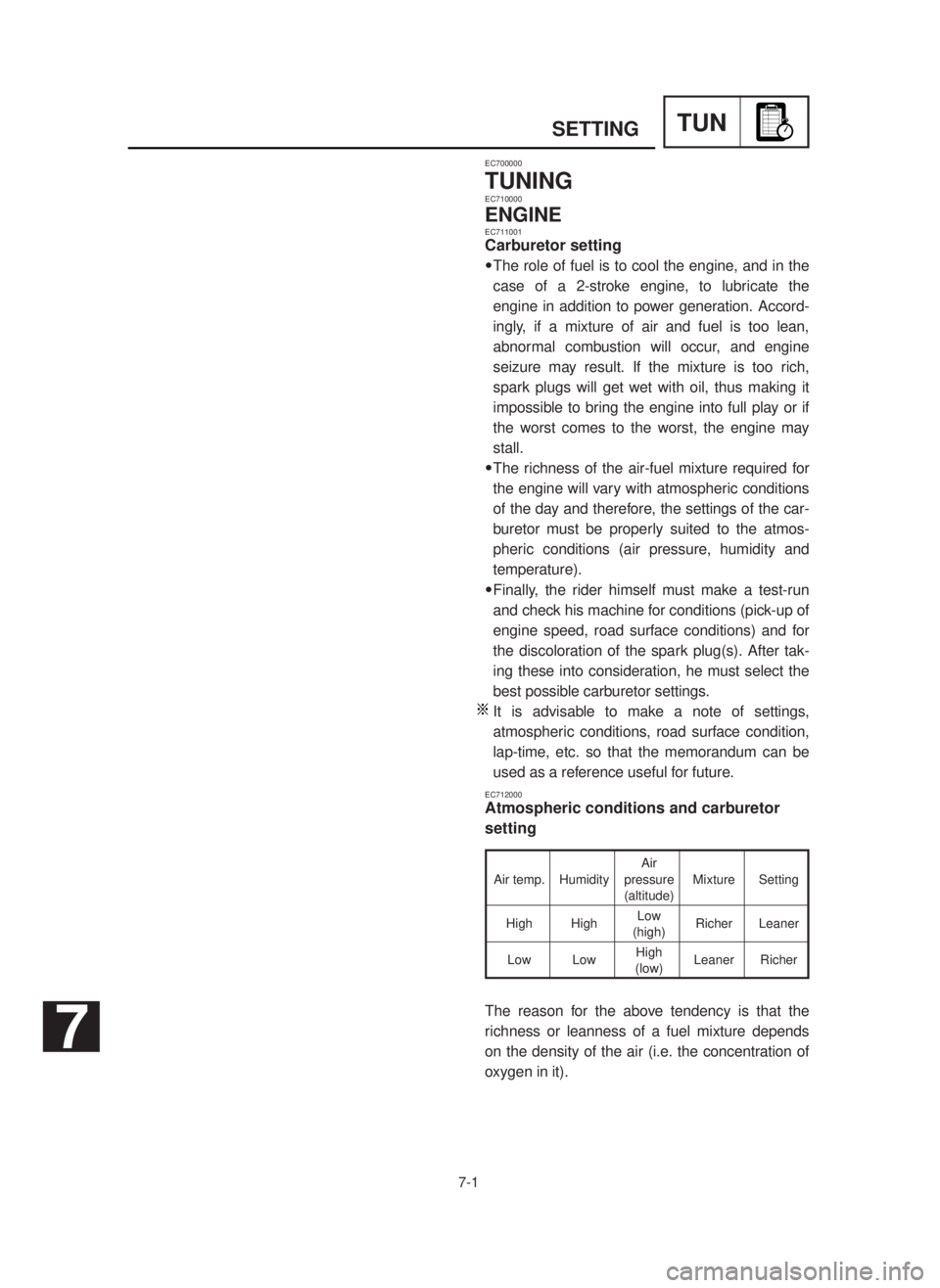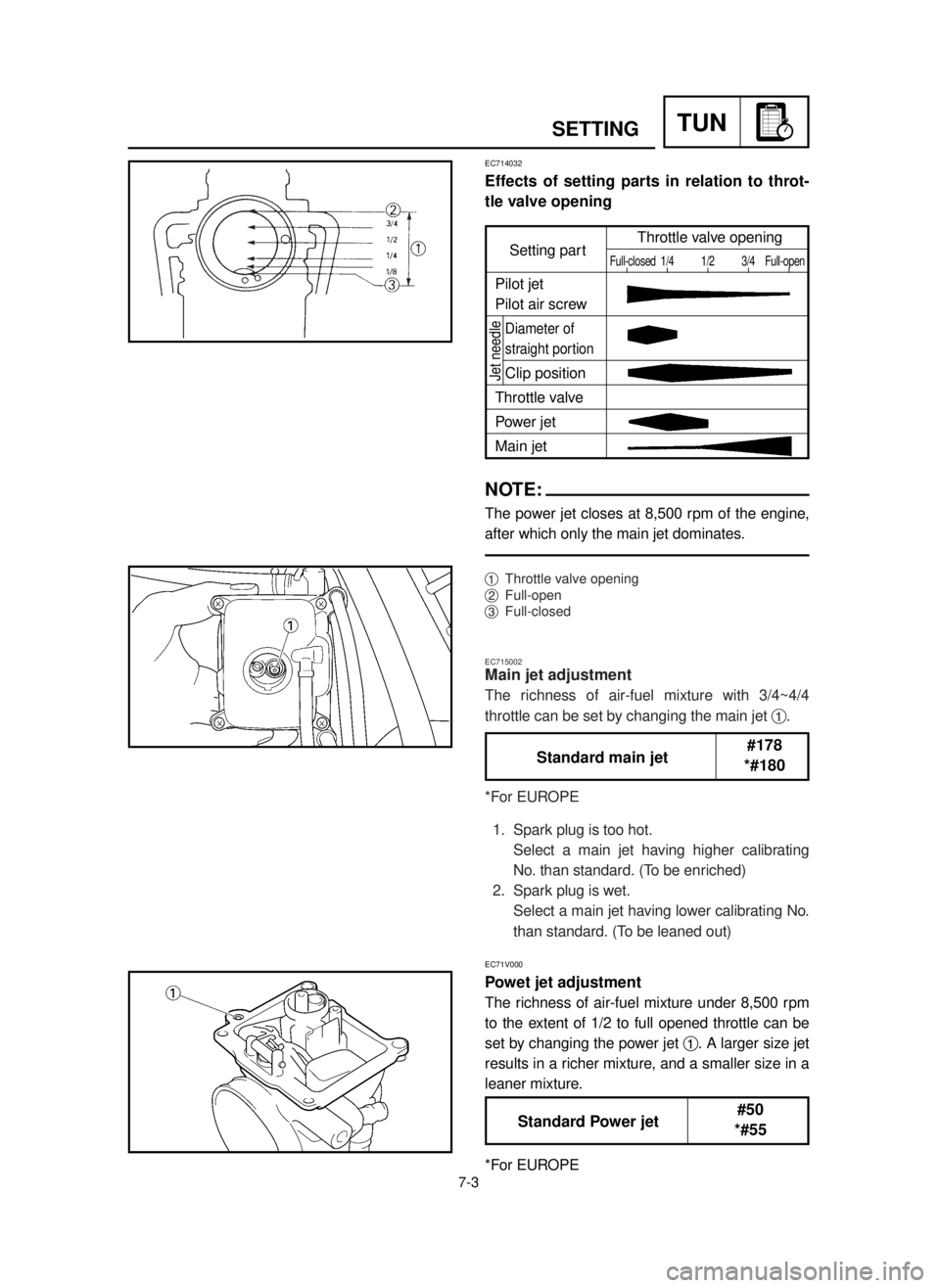Page 514 of 578
6-10
TPS (THROTTLE POSITION SENSOR) SYSTEMELEC
EC693000
TPS REPLACEMENT AND ADJUSTMENT
1. Remove:
9Carburetor
9Mixing chamber top
Refer to “CARBURETOR AND REED
VALVE” section in the CHAPTER 4.
2. Remove:
9Screw (TPS) 1
9Plain washer 2
9TPS 3
NOTE:
Loosen the screws using the T20 bit (tamper
resistant fastener type).
3. Replace:
9TPS
4. Install:
9TPS 1
9Plain washer 2
9Screw (TPS) 3
NOTE:
9Align the slot ain the TPS with the projection
bon the carburetor.
9Temporarily tighten the screws (TPS).
5. Install:
9Mixing chamber top
9Carburetor
Refer to “CARBURETOR AND REED
VALVE” section in the CHAPTER 4.
6. Start the engine and thoroughly warm it up.
5MW-9-30-6 7/6/00 1:39 PM Page 26
Page 516 of 578
6-11
TPS (THROTTLE POSITION SENSOR) SYSTEMELEC
7. Adjust:
9Idle speed for TPS adjustment
8. Disconnect the TPS coupler.
9. Calculate:
9TPS coil resistance at idle speed.
If the TPS coil resistance is 5k½, then the TPS
coil resistance at idle speed is:
5k½´(0.13~0.15) = 650~750½
Refer to “TPS COIL INSPECTION” section
about the TPS coil resistance.
10. Adjust:
9TPS coil resistance at idle speed
Idle speed for TPS adjustment:
1,700~1,900 rpm
Adjustment steps:
9Set the inductive tachometer (engine
tachometer) to the high tension cord.
9Turn the throttle stop screw 1until the
specified idle speed.
Refer to “IDLE SPEED ADJUSTMENT” sec-
tion in the CHAPTER 3.
TPS coil resistance at idle speed:
TPS coil resistance ´(0.13~0.15)
Tester (+) leadÕYellowlead 2
Tester (–) lead
ÕBlacklead 3 Adjustment steps:
Adjust the angle of the TPS 1to obtain the
resistance calculated (example: 650~750½).
5MW-9-30-6 7/6/00 1:39 PM Page 28
Page 518 of 578
6-12
TPS (THROTTLE POSITION SENSOR) SYSTEMELEC
11. Put the aligning marks aon the TPS and
carburetor.
12. Remove:
9Carburetor
Refer to “CARBURETOR AND REED
VALVE” section in the CHAPTER 4.
13. Tighten:
9Screw (TPS) 1
NOTE:
Tighten the screws (TPS) using the T20 bit (tam-
per resistant fastener type) by aligning the marks
athat were put before removal.
14. Install:
9Carburetor
Refer to “CARBURETOR AND REED
VALVE” section in the CHAPTER 4.
EC694000
TPS INPUT VOLTAGE INSPECTION
1. Disconnect the TPS coupler.
2. Start the engine.
3. Inspect:
9TPS input voltage
Out of specification ÕReplace the CDI
unit.
Tester (+) leadÕBluelead 1
Tester (–) lead
ÕBlacklead 2
TPS input Tester selector
voltage position
4~6V DCV-20
5MW-9-30-6 7/6/00 1:40 PM Page 30
Page 520 of 578

7-1
SETTINGTUN
EC700000
TUNINGEC710000
ENGINEEC711001
Carburetor setting
9The role of fuel is to cool the engine, and in the
case of a 2-stroke engine, to lubricate the
engine in addition to power generation. Accord-
ingly, if a mixture of air and fuel is too lean,
abnormal combustion will occur, and engine
seizure may result. If the mixture is too rich,
spark plugs will get wet with oil, thus making it
impossible to bring the engine into full play or if
the worst comes to the worst, the engine may
stall.
9The richness of the air-fuel mixture required for
the engine will vary with atmospheric conditions
of the day and therefore, the settings of the car-
buretor must be properly suited to the atmos-
pheric conditions (air pressure, humidity and
temperature).
9Finally, the rider himself must make a test-run
and check his machine for conditions (pick-up of
engine speed, road surface conditions) and for
the discoloration of the spark plug(s). After tak-
ing these into consideration, he must select the
best possible carburetor settings.
It is advisable to make a note of settings,
atmospheric conditions, road surface condition,
lap-time, etc. so that the memorandum can be
used as a reference useful for future.
EC712000
Atmospheric conditions and carburetor
setting
The reason for the above tendency is that the
richness or leanness of a fuel mixture depends
on the density of the air (i.e. the concentration of
oxygen in it).
Air
Air temp. Humidity pressure Mixture Setting
(altitude)
High HighLow
Richer Leaner
(high)
Low LowHigh
Leaner Richer
(low)
7
5MW-9-30-7 7/6/00 2:15 PM Page 2
Page 522 of 578
7-2
SETTINGTUN
That is:
9Higher temperature expands the air with its
resultant reduced density.
9Higher humidity reduces the amount of oxygen
in the air by so much of the water vapor in the
same air.
9Lower atmospheric pressure (at a high altitude)
reduces the density of the air.
EC713001
Test run
After warming up the engine equipped with the
standard type carburetor(s) and spark plug(s),
run two or three laps of the circuit and check the
smooth operation of the engine and discoloration
of spark plug(s).
ŒNormal
ºOver burned (too lean)
Oil fouled (too rich)
Discoloration Condition of spark plug
NormalInsulator is dry and
burnt brown.
Over burned
Insulator is whitish.
(too lean)
Oil fouled Insulator is sooty and
(too rich) wet.
A
B
C
5MW-9-30-7 7/6/00 2:16 PM Page 4
Page 524 of 578

7-3
SETTINGTUN
EC714032
Effects of setting parts in relation to throt-
tle valve opening
NOTE:
The power jet closes at 8,500 rpm of the engine,
after which only the main jet dominates.
1Throttle valve opening
2Full-open
3Full-closed
EC715002
Main jet adjustment
The richness of air-fuel mixture with 3/4~4/4
throttle can be set by changing the main jet 1.
*For EUROPE
1. Spark plug is too hot.
Select a main jet having higher calibrating
No. than standard. (To be enriched)
2. Spark plug is wet.
Select a main jet having lower calibrating No.
than standard. (To be leaned out)
Standard main jet#178
*#180
EC71V000
Powet jet adjustment
The richness of air-fuel mixture under 8,500 rpm
to the extent of 1/2 to full opened throttle can be
set by changing the power jet 1. A larger size jet
results in a richer mixture, and a smaller size in a
leaner mixture.
*For EUROPE
Standard Power jet#50
*#55
Setting partThrottle valve openingFull-closed 1/4 1/2 3/4 Full-open
Pilot jet
Pilot air screw
Diameter of
straight portion
Clip position
Throttle valve
Power jet
Main jet
Jet needle
5MW-9-30-7 7/6/00 2:17 PM Page 6
Page 526 of 578

7-4
SETTINGTUN
EC71R000
Pilot jet adjustment
The air-fuel mixture can basically be adjusted by
the pilot air screw from full closed to 1/8 throttle.
If the pilot air screw is not enough for this adjust-
ment, the pilot jet 1is changed.
A larger size jet results in a richer mixture at low
speeds, and a smaller size in a leaner mixture.
EC718001
Jet needle groove position adjustment
Should the engine be hard to run smoothly at
intermediate speeds, the jet needle 1must be
adjusted. If the mixture is too rich or too lean at
intermediate speed operation, irregular engine
operation and poor acceleration will result.
Whether or not the richness of the mixture is
proper is hard to be determined by means of the
spark plug and therefore, it should be judged
from your feeling of actual engine operation.
*For EUROPE
Standard pilot jet#50
*#55
EC716001
Pilot air screw adjustment
The richness of air-fuel mixture with full closed to
1/8 throttle can be set by turning the pilot air
screw 1.
Turning in the pilot air screw will enrich the mix-
ture at low speeds, and turning out it will lean out
the mixture.
*For EUROPE
*For EUROPE
Standard pilot air1 turn out
*1-3/4 turns out
screw position
(for reference only)
Standard clip positionNo.2 groove
*No 3 groove
5MW-9-30-7 7/6/00 2:17 PM Page 8
Page 528 of 578
7-5
SETTINGTUN
1. Too rich at intermediate speeds
Rough engine operation is felt and the
engine will not pick up speed smoothly. In
this case, step up the jet needle clip by one
groove and move down the needle to lean
out the mixture.
2. Too lean at intermediate speeds
The engine breathes hard and will not pick
up speed quickly.
Step up the jet needle clip by one groove
and move up the needle to enrich the mix-
ture.
5MW-9-30-7 7/6/00 2:17 PM Page 10